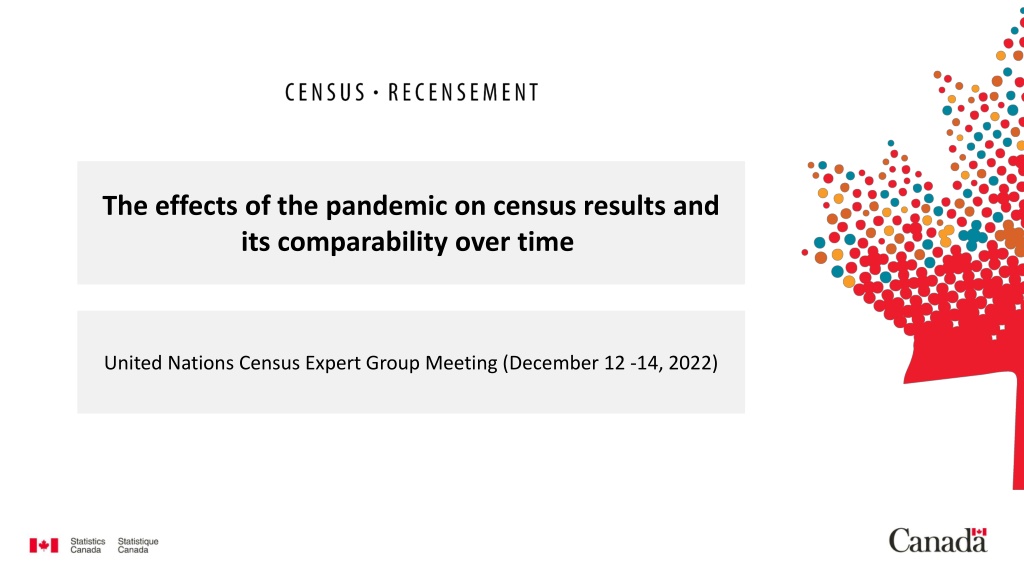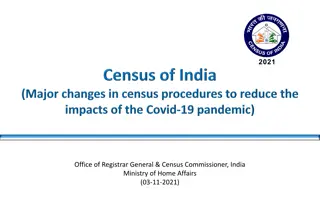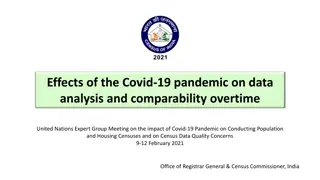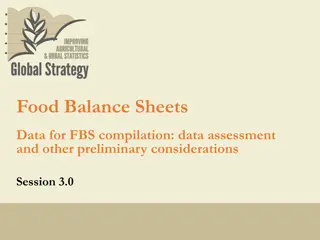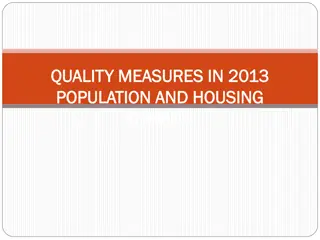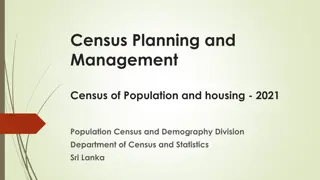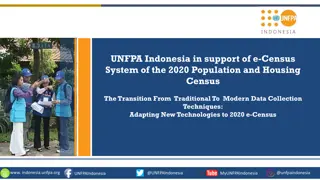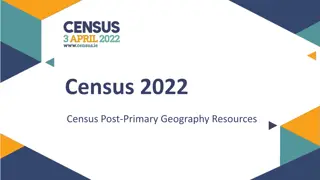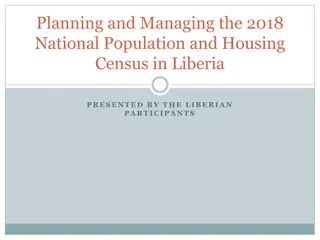Analysis of Pandemic's Impact on Census Results and Comparability Over Time
The United Nations Census Expert Group Meeting in December 2022 discussed the effects of the pandemic on census results and comparability over time. Global collection response rates from the 2016 and 2021 censuses, along with cumulative total response data, highlighted the success of the 2021 Census despite challenges. Mitigation strategies were implemented to ensure data comparability. The initial release emphasized transparency regarding methodological changes and cautions for historical comparisons.
Download Presentation

Please find below an Image/Link to download the presentation.
The content on the website is provided AS IS for your information and personal use only. It may not be sold, licensed, or shared on other websites without obtaining consent from the author. Download presentation by click this link. If you encounter any issues during the download, it is possible that the publisher has removed the file from their server.
E N D
Presentation Transcript
The effects of the pandemic on census results and its comparability over time United Nations Census Expert Group Meeting (December 12 -14, 2022)
Global Collection Response Rates - Highlights 2016 Census 2021 Census Collection Rate Actual Planned Actual Global Census Collection Rate 98.4% 98% 98.0% Long Form Collection rate 97.9% 96% 97.4% Internet 68.3% 80% 84.1% Paper 20.5% 10% 4.1% Self-Response 88.8% 90% 88.1% NRFU 9.7% 8% 9.9% Workload at start of NRFU 3.7 M 4.0M 4.6M 2
Response Rates Cumulative Total Response Daily Self-Response May 11 CENSUS DAY May 11 CENSUS DAY 100.0% 1,600,000 12.0% 90.0% 1,400,000 10.0% 80.0% 1,200,000 70.0% 8.0% 1,000,000 60.0% 50.0% 800,000 6.0% 40.0% 600,000 4.0% 30.0% 400,000 20.0% 2.0% 200,000 10.0% 0.0% 0 0.0% 03/05/2021 07/05/2021 11/05/2021 15/05/2021 19/05/2021 23/05/2021 27/05/2021 31/05/2021 04/06/2021 08/06/2021 12/06/2021 16/06/2021 20/06/2021 24/06/2021 28/06/2021 02/07/2021 06/07/2021 10/07/2021 14/07/2021 18/07/2021 22/07/2021 26/07/2021 30/07/2021 03/08/2021 07/08/2021 11/08/2021 15/08/2021 19/08/2021 23/08/2021 27/08/2021 31/08/2021 03/05/2021 07/05/2021 11/05/2021 15/05/2021 19/05/2021 23/05/2021 27/05/2021 31/05/2021 04/06/2021 08/06/2021 12/06/2021 16/06/2021 20/06/2021 24/06/2021 28/06/2021 02/07/2021 06/07/2021 10/07/2021 14/07/2021 18/07/2021 22/07/2021 26/07/2021 30/07/2021 03/08/2021 07/08/2021 11/08/2021 Actual Response Rate Planned data self_responses self_response_rate 3
Comparability of census results - Initial release main message to users: COVID-19 presented some challenges for conducting the Census. But despite these, the collection response rate for the country as a whole was a resounding success at 98%. Overall quality was not compromised because of the pandemic. All Census releases discussed the impacts of the pandemic on observed results and some comparability challenges, when relevant. Reference guides were also transparent about methodological changes and possible incidence on comparability: - Ex. Dwelling reference guide : the enumeration of collective dwellings underwent substantial changes in the 2021 Census, notably because of the COVID-19 pandemic. - In this context, changes in collection procedures for collective dwellings may have had an impact on the historical comparability of collective dwelling data. Because of this, caution must be used when making a historical comparison. Etc. As usual, users are encouraged to use all data quality indicators available to judge the quality of estimates from the 2021 Census and the 2016 Census programs when assessing the reliability of comparisons. - - - 7
Mitigation strategies for comparability: collection Respondents were instructed to choose the responses that best reflected their situation or the situation of members of the household for the date or time period in question (as in previous censuses). Additional instructional text was also provided in help features in the online questionnaires. For ex. LANGUAGE: Do not report languages that this person uses solely at work even if this person now works from home (for example, because of the COVID-19 pandemic). EDUCATION: Select Yes, high school diploma if this person obtained a high school diploma: even if it was outside Canada; even if some aspects of the school year (such as final exams or graduation ceremonies) were cancelled or changed because of the COVID-19 pandemic PLACE OF WORK: Because of the COVID-19 pandemic, many workers have adapted to working under different conditions than what is typical for them, such as working at home instead of at their employer s address. When reporting this person s place of work, if there remains uncertainty about what usual means, please respond based on where they worked for most or all the week of May 2 to May 8, 2021. PAID CHILD CARE USE: The amount of child-care paid in 2020 should not include periods for which no child-care service was paid due to circumstances surrounding the COVID-19 pandemic. Etc. 7
Census results impacted by the pandemic Census results impacted by methodological challenges associated with the pandemic (collection, etc.) Census results not impacted or marginally impacted by the pandemic Population and dwelling counts Indigenous Population and dwelling counts Age, sex at birth and gender Income Other Indigenous peoples data Familes, households, and marital status Housing Canadian military experience Commuting and Place of work Type of dwelling Labour Language Mobility and migration Ethnocultural and religious diversity Immigration, place of birth and citizenship Education 6
Population counts: Pandemic slows growth but Canada's population grew fast, from 2016 to 2021. Immigration, not fertility, mostly drove Canada's population growth from 2016 to 2021 and was also the main reason for the slowdown since 2020 due to border restrictions. In 2020, the population of Canada only increased by 0.4% (+149,461), from a record high in 2019 (up 583,000 or +1.6%) 2020 had the lowest annual growth since 1945 (in number) and 1916 (in percent): both periods when Canada was at war. Most of this reduction was to due to pandemic-related border and travel restrictions, including to immigration. In 2020, population growth through international migration was >80% lower than in 2019. COVID-19 deaths had a limited effect on the slowdown in Canada's population growth. The rate of natural increase fell 0.3% from 2016 to 0.1% in 2021. Due to the pandemic, life expectancy at birth for both sexes declined by 0.57 years between 2019 and 2020. This is the largest annual decline in life expectancy since the vital statistics registration system was introduced in 1921. Changes to mortality did not have a major effect on overall population counts. Interprovincial migration during the pandemic led to higher population growth in the Maritimes than that of the Prairies. 7
Immigration A record number of new immigrants arrived in Canada from 2016 to 2021, despite the record low number in 2020. The COVID-19 pandemic highlighted the contribution that immigrants make to Canada's labour market. From 2016 to 2021, immigration contributed to 79.9% of the growth in Canada's labour force. 8
Population aging The COVID-19 pandemic slowed population growth in all age groups, but especially among younger population (because of the contribution of immigration to these groups). The pandemic caused many deaths among the very old. However, it has not had a significant impact on population aging. Main reason: the 12,900 additional deaths due to COVID-19 among the population 65 years and older from March 1, 2020 to May 15, 2021 was significantly lower than the increase of nearly 245,000 people in this population, an increase driven by those who turned 65 in 2020. And while the COVID-19 pandemic claimed many lives among the oldest Canadians, this population continued to grow rapidly. The population aged 85 and older is one of the fastest-growing age groups, with a 12% increase from 2016. 9
Income According to the 2021 Census of Population, the pandemic has had a significant impact on the earnings of Canadians: Fewer Canadians received employment income in 2020, particularly women, lower-income earners and older workers. The proportion of Canadians receiving employment income fell in most of the provinces and territories. During the pandemic, earnings fell in lower-paying service sectors such as accommodation and food services; arts, entertainment and recreation; and retail trade. During this time, the Canadian government rolled out pandemic relief benefits: More than two-thirds of Canadians benefited from at least one of the pandemic relief programs The poverty rate in Canada decreased from 14.5% in 2015 to 8.1% in 2020, partially driven by these temporary benefits. Comparability of Census results on poverty: The Canadian Income Survey will shed light on poverty trends in the post-pandemic period, including the extent to which the lower poverty rates observed in 2020 will be sustained in 2021 and 2022, in the context of inflationary pressures not seen in decades. Income inequality fell in all provinces and territories from 2015 to 2020, with Alberta reporting the largest decline. 10
Income: additional information available to users to help with comparability - To facilitate analysis of the economic impact of the COVID-19 pandemic, other classifications of government transfers, which set COVID-19-related income support programs apart from other government transfer income, are available with 2021 Census data. - COVID-19 Government income support and benefits - COVID-19 Emergency and recovery benefits - COVID-19 Canada Emergency Response Benefit (CERB) - COVID-19 Canada Recovery Benefit (CRB) - COVID-19 Canada Recovery Caregiving Benefit (CRCB); etc. - COVID-19 Enhancements to existing federal programs - COVID-19 Provincial and territorial benefits. For the first time: crucial income sources for reference year 2019, that provide baseline information to assess the economic impact of the COVID-19 pandemic, are available - 11
Housing The rate of unaffordable housing, or the proportion of households that spent 30% or more of their income on shelter costs, fell from 24.1% in 2016 to 20.9% in 2021, largely due to pandemic relief transfers. Rate of unaffordable housing for renters : from 40.0% in 2016 to 33.2% in 2021. Rate of unaffordable housing for owners: from 16.6% in 2016 to 14.8% in 2021. Differences in the impact of temporary COVID-19 benefits on household incomes for renters and for homeowners were a key contributor to the different degrees of improvement in housing affordability seen for each group, from 2016 to 2021. The median household income of renters grew by 31.7% between 2015 and 2020. At the same time, owners saw their median household income grow by 14.6%. Comparability challenges: drop in unaffordable housing in 2021 may be temporary situation With the last temporary COVID-19 benefits being phased out in early 2022, combined with the highest rate of inflation in 40 years particularly for life's essentials there could be further pressure on households that are already struggling to make ends meet. 12
Indigenous populations Collection of Census data in many Indigenous communities was challenging during the pandemic. Data collection could not be completed in some situations due to the pandemic or forest fires, or in cases where a given First Nation did not grant permission for data collection. In addition, census collection was paused or halted entirely in several First Nations communities after the tragic confirmation of the unmarked graves of children who had attended residential schools. Due to changes in the number of incompletely enumerated reserves and settlements over time, comparability to previous Census years may be affected. Two new questions were added in 2021: 1) Is this person a registered member of a M tis organization or Settlement?, and 2) Is this person enrolled under, or a beneficiary of, an Inuit land claims agreement?. The 2021 Census also marked the first time that low-income data were made available for all geographic regions in Canada, including reserves and northern areas. Of the 1.8 million Indigenous people living in Canada in 2021, 18.8% lived in a low-income household, as defined using the low- income measure, after tax, compared with 10.7% of the non-Indigenous population. The share of Indigenous people living in a low-income household was much lower in 2021 than in 2016 (18.8% versus 28.1%), due in large part to government transfers made in response to the COVID-19 pandemic. 7
Labour At the time of the Census (May 2021), a large number of Canadians were working reduced hours or had been laid off due to the pandemic. In May 2021, employment remained below its pre-pandemic level (-559,000 or -2.9%) and the unemployment rate stood at 8.0%, compared with its peak of 13.4% reached in May 2020. In particular during the third wave of the pandemic in the spring of 2021, employment in sales and service occupations were particularly affected by closures or reductions to customer capacity These occupations still accounted for nearly one quarter (23.1%) of employment in May 2021, the largest share of total employment among all industries. Driven by the needs of an aging population and in response to the pandemic, the number of health care workers increased by 204,000 (+16.8%) over 5 years. Occupations requiring a high school education or no formal training were hardest hit by the pandemic. 7
Place of work and Commuting: comparability challenges - While conceptually comparable over time, May 2021 place of work data may be a data starting point of new patterns in working at home and commuting - May 2021 commuting flows may not be reflective of December 2022 traffic flows. However, there is still value for urban planners, given that working at home does not appear to be a waning phenomenon - Remaining questions: - Will working from home remain at such high levels? Will public transit commuting return to pre-pandemic levels? 7
Mitigation strategies for comparability - Additional Statistics Canada data were used in analytical products to: - Contextualize the results with analysis depicting the effects of the pandemic - Highlight trends from COVID-19 that are temporary or likely to stay in the long-term o o Population projections Population and Dwelling counts Canadian Social Survey (CSS, Omnibus Survey) Families and Households Language Immigration and ethnocultural diversity Education Canadian Housing Survey (CHS) Housing Administrative data on primary and secondary schooling Instruction in the official minority language Education and Labour Market Longitudinal Linkage Platform (ELMLP) Education Canadian Emergency Response Benefit (CERB) Income Employment Insurance (EI) data Labour Income Labour Force Survey (LFS) Labour and Commuting Education Job Vacancy and Wage Survey (JVWS) Labour Survey of Employment Payrolls and Hours (SEPH) Labour Various public domain sources for Commuting OECD and World Bank reports Potentially the vast majority of topics o o o o o o o o o o 7
